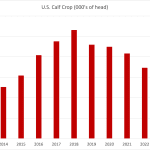With grain and oilseed prices rising and fears of food price inflation growing, some U.S. groups are lobbying for changes to their country’s conservation reserve program (CRP).
Grain processors and consumer groups are among those saying the amount of land devoted to growing grain and oilseeds must increase in 2008 to meet demand and keep prices under control. They see CRP land as one potential source of that additional acreage.
However, a significant reduction in the 35 million acres enrolled in the CRP could have a negative impact on grain prices for Canadian growers.
Read Also

Canola used in only quarter of Canadian biofuel
Less than one-quarter of the biodiesel and renewable diesel used in Canada in 2024 was made from canola oil feedstock
Proposals from those looking for changes include allowing producers to opt out of their CRP contracts early without penalty and doing away with the program altogether.
But one Washington-based agricultural economist says despite all the talk, he thinks changes that significantly reduce CRP acreage are unlikely.
“I believe the program will continue to hold most of its acres,” said Bill Tierney, executive vice-president of research and marketing for the consulting firm John Stewart and Associates and former chief grain economist with the U.S. Department of Agriculture.
“That seems to be the consensus among the people who are most knowledgeable about the program.”
He said a powerful coalition of groups has a vested interest in keeping the program as it is, including agricultural landowners who fear a decline in land values if CRP acres are released, conservation and hunting groups, and agricultural lenders.
“That coalition is generally perceived to be more influential by a considerable degree than the faction looking for changes that would put more land into production,” Tierney said.
Producers can opt out of the program when their 10 to 15 year contracts expire. About two million acres expired on Sept. 30, but it’s not yet clear how much of that was rolled into new contracts or taken out of the program.
Under the CRP, farmers are paid to take marginal crop land, wetlands and wildlife habitat out of grain or oilseed production and seed it to grasses and forages.
Payments vary from state to state. In Montana, for example, farmers received an average of $33.63 US per acre last year, while in Wyoming they were paid $27.55. Total CRP payments were $1.8 billion.
The program is up for renewal in the 2007 farm bill, which is being debated in the U.S. Senate. Both the Senate and House of Representatives versions of the bill leave the CRP essentially as it is now.
While it’s possible an amendment could be introduced to allow early opt-out, the acting agriculture secretary recently said that’s not going to happen.
Vince Smith, an agricultural economist at Montana State University, said that’s the right decision.
“That is a binding contract,” he told a Montana newspaper.
“If you renege on it you are liable for the money.”
In Montana, about 616,000 contract acres expired Sept 30. It’s expected most of that will go back into the program. Rates are based on the local land market.
Bill Lapp, president of Advanced Economic Solutions and a former senior official at ConAgra Inc., recently made the argument for change.
He told Reuters News Agency that if demand from the food, feed and biofuel industries stays steady, there will have to be an increase of seven million acres of wheat, corn, soybeans and cotton to meet that demand.
If more acres are not seeded, he said, there will be a continuation in new higher benchmarks for grain and oilseed prices, inflationary increases in food prices and a reduction in food and fuel industry profits.
“We’re going to see prices elevated and not return to where they were,” Lapp said.
















